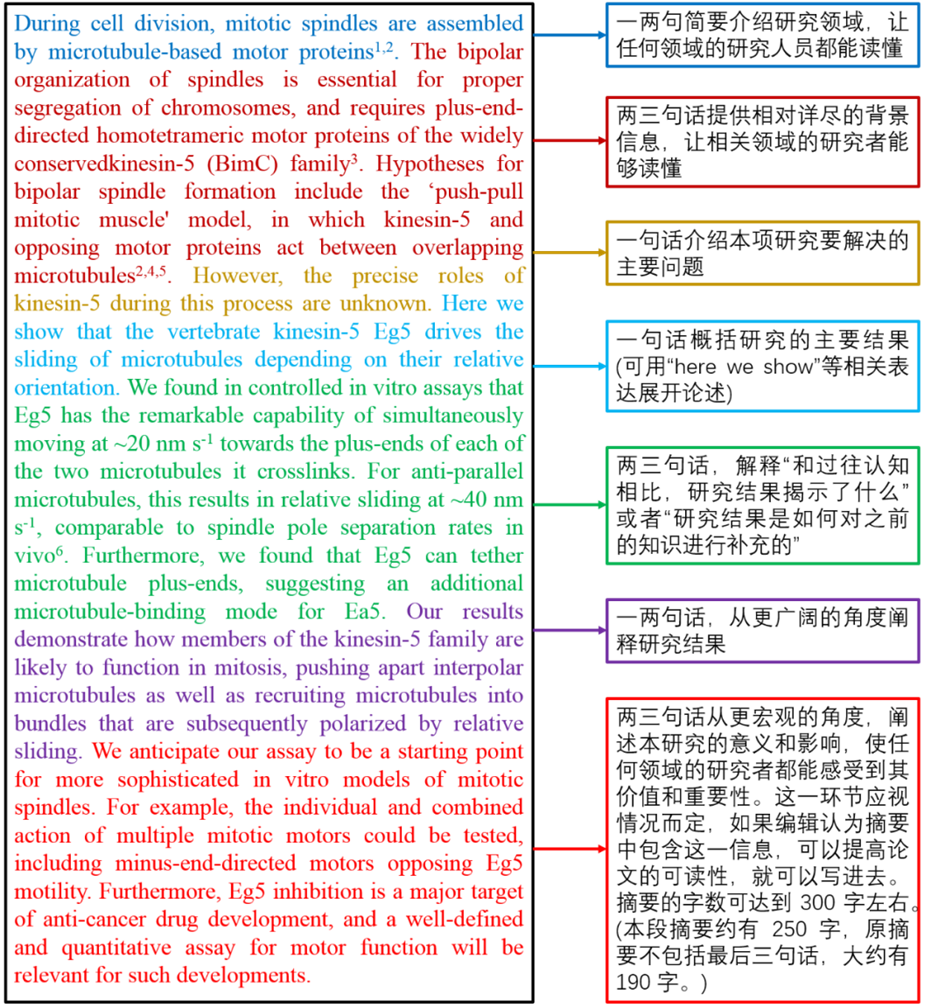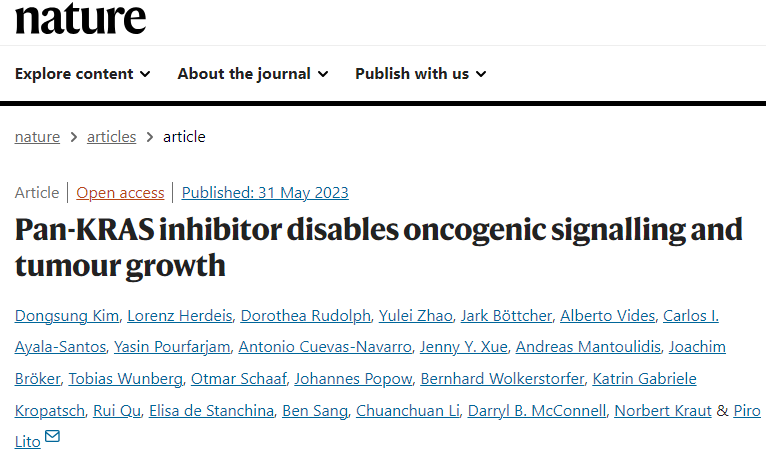论文被阅读次数最多的是标题,其次就是摘要。当读者看到感兴趣的题目,就会去阅读摘要,如果摘要内容成功地吸引了读者的注意,才会选择点进网页去阅读作者论文的主体部分,去关注作者的观点。既然摘要担负起了“招揽顾客”的作用,而且还要有高度凝练和概括,那么如何才能写好英文的摘要呢?
01摘要写法
SCI论文通常采用结构化的摘要,其基本组成部分是:
· 引言/问题陈述:我们为什么要关注该问题?当前该问题存在哪些研究上的不足?如果研究的问题非常普遍,大家基本都了解,可简单地描述;
· 研究方法/过程:用什么方法通过什么步骤得到研究结果?
· 研究结果:取得了什么样的研究结果?给出关键的发现、数据或统计结果,但不需展示具体的数据。
· 结论/讨论:通过分析结果,得到了什么结论?分析研究结果的意义和影响,是否对第一点提到的研究不足有改进?
02 高分案列
案例一
Nature 官方摘要模板,以《The bipolar mitotic kinesin Eg5 moves on both microtubules that it crosslinks》为例:

案例二
以Nature 2023年发表的《Pan-KRAS inhibitor disables oncogenic signaling and tumour growth》为例:

链接:https://doi.org/10.1038/s41586-023-06123-3
01提供介绍性背景信息,引出你的目标陈述
第一部分的1-3句话必须让读者知道你为什么进行这项研究。
例子
KRAS is one of the most commonly mutated proteins in cancer, and efforts to directly inhibit its function have been continuing for decades. The most successful of these has been the development of covalent allele-specific inhibitors that trap KRAS G12C in its inactive conformation and suppress tumor growth in patients1,2,3,4,5,6,7. Whether inactive-state selective inhibition can be used to therapeutically target non-G12C KRAS mutants remains under investigation.
这一引导性句子既陈述了主要议题(想要开发一种非共价抑制剂来抑制KRAS突变蛋白),也说明了问题(非共价抑制剂仍在研究中)。这样,读者的注意力被立刻抓住了。下一个句子可以接着讲述这个领域缺乏什么样的信息,或者以前的研究者曾做了哪些努力来解决这个问题。
这样的陈述可以很自然地引出关于你的研究如何能独特地解决这个问题的陈述。
· 使用诸如“Here, we aimed to…”或“Here, we demonstrate that…”等句子来向读者表明你在陈述你的研究目标或目的。
02简短介绍你的方法
摘要的方法部分是概括你的研究基本设计的机会,过度的细节并不需要。
例子
Here we report the discovery and characterization of a non-covalent inhibitor that binds preferentially and with high affinity to the inactive state of KRAS while sparing NRAS and HRAS.
生物或临床领域的摘要应该提到研究的生物体、细胞系或种群。如果是生态论文,研究地点通常是重要的信息。临床试验方面的论文应该提到样本大小、病人组群、剂量和研究持续时间。
· 经典句式如:“Here we report…”,“Here, we performed that… ”
03清楚描述研究最重要的发现
别人看你的摘要的主要原因是为了了解你的发现。因此,结果应该是摘要最长的部分,你应该提供尽量详尽的细节。
语句1
Although limited to only a few amino acids, the evolutionary divergence in the GTPase domain of RAS isoforms was sufficient to impart orthosteric and allosteric constraints for KRAS selectivity.
语句2
Inhibition of downstream signalling and proliferation was restricted to cancer cells harboring mutant KRAS, and drug treatment suppressed KRAS mutant tumor growth in mice, without having a detrimental effect on animal weight.
语句1使用“although”一词起到强调作用,总体上来说RAS亚型的 GTP 酶结构域的进化差异生物作用很大。从写作结构来看这样的陈述并没有提供很多信息,相反,要考虑做出更具体的陈述;如语句2,该抑制剂不仅能阻止野生型KRAS,还能阻止多种KRAS突变体的激活,注意用到了“a broad range of”这个词。
04简洁陈述结论并避免夸大
摘要的最后1-2句话应该用来概括研究的关键信息:你的结论。
例子
Our study suggests that most KRAS oncoproteins cycle between an active state and an inactive state in cancer cells and are dependent on nucleotide exchange for activation. Pan-KRAS inhibitors, such as the one described here, have broad therapeutic implications and merit clinical investigation in patients with KRAS-driven cancers.
可以使用诸如“Our study suggests/revealed that…”或“Overall, we conclude that…”这样的句子。然后,尽量简洁地陈述你的主要发现。如果你有其它有意思的次要发现,也可以提及它们。
最后,考虑写一句陈述有关你的工作的理论性或实践性意义的话,以及/或者你的工作如何推动整个领域发展,比如上面的“have broad therapeutic implications and merit clinical investigation…”这将帮助读者更清楚地了解你的发现的重要性。
如前面提到的,很多无法得到你的文稿全文的读者会阅读你的摘要,由于无法得到你的数据,他们只能照单全收你的结论。因此,在摘要里不要夸大结论的重要性以致误导读者。
以上就是对SCI论文摘要写法的详细介绍,希望对大家有帮助。













